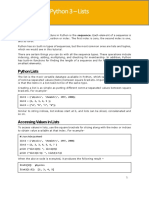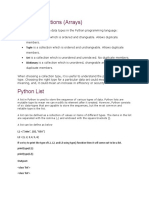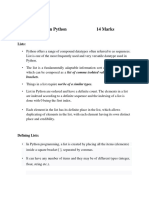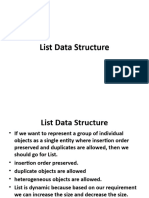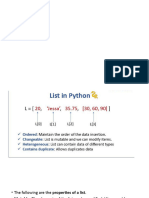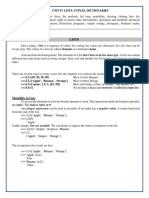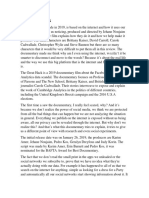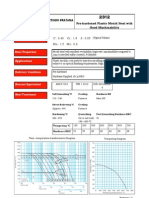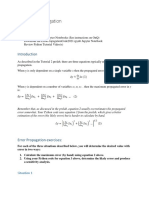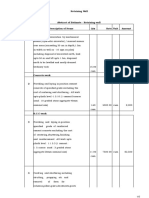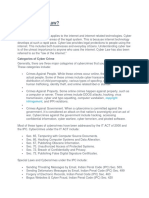Artificial Intelligence
Department of Computer Science
University of Engineering and Technology, Lahore
Class Learning Outcomes
Students will learn about the following concepts in Python
• Arrays
• Lists
• Tuples
• Sets
• Dictionary
What is an Array?
An array is a special variable, which can hold more than one value at a time. If you
have a list of items (a list of car names, for example), storing the cars in single
variables could look like this:
car1 = "Ford" car2
= "Volvo" car3 =
"BMW"
However, what if you want to loop through the cars and find a specific one? And
what if you had not 3 cars, but 300?
The solution is an array!
An array can hold many values under a single name, and you can access the values
by referring to an index number.
Access the Elements of an Array
You refer to an array element by referring to the index number.
Example
Get the value of the first array item:
x = cars[0]
Example
Modify the value of the first array item:
cars[0] = "Toyota"
The Length of an Array
Use the len() method to return the length of an array (the number of elements in an
array).
Example
Return the number of elements in the cars array:
x = len(cars)
Note: The length of an array is always one more than the highest array
index.
Looping Array Elements
You can use the for in loop to loop through all the elements of an array.
Example
Print each item in the cars array:
for x in cars:
print(x)
Adding Array Elements
You can use the append() method to add an element to an array.
Example
Add one more element to the cars array:
cars.append("Honda")
Removing Array Elements
You can use the pop() method to remove an element from the array.
Example \
Delete the second element of the cars array:
cars.pop(1)
You can also use the remove() method to remove an element from the array.
Example
Delete the element that has the value "Volvo":
cars.remove("Volvo")
Note: The remove() method only removes the first occurrence of the
specified value.
Array Methods
Python has a set of built-in methods that you can use on lists/arrays.
Method Description
append() Adds an element at the end of the list
clear() Removes all the elements from the list
copy() Returns a copy of the list
count() Returns the number of elements with the specified value
extend() Add the elements of a list (or any iterable), to the end of the current list
index() Returns the index of the first element with the specified value
Note: Python does not have built-in support for Arrays, but Python Lists
can be used instead.
insert() Adds an element at the specified position
pop() Removes the element at the specified position
remove() Removes the first item with the specified value
reverse() Reverses the order of the list
sort() Sorts the list
Python List:
The list is a most versatile datatype available in Python which can be written as a
list of commaseparated values (items) between square brackets. Important thing
about a list is that items in a list need not be of the same type.
Creating a list is as simple as putting different comma-separated values between
square brackets. For example −
list1 = ['physics', 'chemistry',
1997, 2000]; list2 = [1, 2, 3, 4, 5
]; list3 = ["a", "b", "c", "d"]
Similar to string indices, list indices start at 0, and lists can be sliced, concatenated
and so on.
Accessing Values in Lists
To access values in lists, use the square brackets for slicing along with the index or
indices to obtain value available at that index. For example −
list1 = ['physics', 'chemistry', 1997, 2000];
list2 = [1, 2, 3, 4, 5, 6, 7 ];
print "list1[0]: ", list1[0]
print "list2[1:5]: ", list2[1:5]
When the above code is executed, it produces the following result −
list1[0]:
physics
list2[1:5]: [2, 3,
4, 5]
Updating Lists
You can update single or multiple elements of lists by giving the slice on the left-
hand side of the assignment operator, and you can add to elements in a list with
the append() method. For example −
list = ['physics',
'chemistry', 1997, 2000];
print "Value available at
index 2 : " print list[2]
list[2] = 2001; print "New
value available at index 2 :
" print list[2]
Note − append() method is discussed in subsequent
section. When the above code is executed, it produces the
following result −
Value available at index 2 :
1997
New value available at index 2 :
2001
Delete List Elements
To remove a list element, you can use either the del statement if you know exactly
which element(s) you are deleting or the remove() method if you do not know. For
example −
list1 = ['physics', 'chemistry', 1997, 2000]; print list1
del list1[2]; print "After deleting value
at index 2 : " print list1
When the above code is executed, it produces following result −
['physics', 'chemistry', 1997, 2000] After deleting value at index 2
:
['physics', 'chemistry', 2000]
Note − remove() method is discussed in subsequent section.
Basic List Operations
Lists respond to the + and * operators much like strings; they mean concatenation
and repetition here too, except that the result is a new list, not a string.
In fact, lists respond to all of the general sequence operations we used on strings in
the prior chapter.
Python Expression Results Description
len([1, 2, 3]) 3 Length
[1, 2, 3] + [4, 5, 6] [1, 2, 3, 4, 5, 6] Concatenation
['Hi!'] * 4 ['Hi!', 'Hi!', 'Hi!', 'Hi!'] Repetition
3 in [1, 2, 3] True Membership
for x in [1, 2, 3]: print x, 123 Iteration
Indexing, Slicing, and Matrixes
Because lists are sequences, indexing and slicing work the same way for lists as they
do for strings.
Assuming following input −
L = ['spam', 'Spam', 'SPAM!']
Python Expression Results Description
L[2] SPAM! Offsets start at zero
L[-2] Spam Negative: count from the
right
L[1:] ['Spam', 'SPAM!'] Slicing fetches sections
Built-in List Functions & Methods
Python includes the following list functions −
Sr.No. Function with Description
1 cmp(list1, list2)
Compares elements of both lists.
2
len(list)
Gives the total length of the list.
3
max(list)
Returns item from the list with max value.
4
min(list)
Returns item from the list with min value.
5
list(seq)
Converts a tuple into list.
Python includes following list methods
Sr.No. Methods with Description
1 list.append(obj)
Appends object obj to list
2
list.count(obj)
Returns count of how many times obj occurs in list
3
list.extend(seq)
Appends the contents of seq to list
4
list.index(obj)
Returns the lowest index in list that obj appears
5
list.insert(index, obj)
Inserts object obj into list at offset index
6
list.pop(obj=list[-1])
Removes and returns last object or obj from list
7
list.remove(obj)
Removes object obj from list
8
list.reverse()
Reverses objects of list in place
9
list.sort([func])
Sorts objects of list, use compare func if given
Python Tuple:
A tuple is a sequence of immutable Python objects. Tuples are sequences, just like
lists. The differences between tuples and lists are, the tuples cannot be changed
unlike lists and tuples use parentheses, whereas lists use square brackets.
Creating a tuple is as simple as putting different comma-separated values. Optionally
you can put these comma-separated values between parentheses also. For example
−
tup1 = ('physics', 'chemistry',
1997, 2000); tup2 = (1, 2, 3, 4, 5
); tup3 = "a", "b", "c", "d";
The empty tuple is written as two parentheses containing nothing −
tup1 = ();
To write a tuple containing a single value you have to include a comma, even though
there is only one value −
tup1 = (50,);
Like string indices, tuple indices start at 0, and they can be sliced, concatenated, and
so on.
Accessing Values in Tuples
To access values in tuple, use the square brackets for slicing along with the index or
indices to obtain value available at that index. For example −
tup1 = ('physics', 'chemistry', 1997, 2000); tup2 = (1, 2, 3, 4, 5, 6, 7 );
print "tup1[0]: ", tup1[0];
print "tup2[1:5]: ", tup2[1:5];
When the above code is executed, it produces the following result −
tup1[0]: physics
tup2[1:5]: [2, 3,
4, 5]
Updating Tuples
Tuples are immutable which means you cannot update or change the values of
tuple elements. You are able to take portions of existing tuples to create new tuples
as the following example demonstrates −
tup1 = (12, 34.56); tup2
= ('abc', 'xyz');
# Following action is not valid for tuples
# tup1[0] = 100;
# So let's create a new tuple as follows
tup3 = tup1 + tup2; print
tup3;
When the above code is executed, it produces the following result −
(12, 34.56, 'abc', 'xyz')
Delete Tuple Elements
Removing individual tuple elements is not possible. There is, of course, nothing
wrong with putting together another tuple with the undesired elements discarded.
To explicitly remove an entire tuple, just use the del statement. For example −
tup = ('physics', 'chemistry', 1997, 2000);
print tup;
del tup;
print "After deleting tup : ";
print tup;
This produces the following result. Note an exception raised, this is because after
del tup tuple does not exist any more −
('physics', 'chemistry', 1997,
2000) After deleting tup :
Traceback (most recent call
last): File "test.py", line 9, in
<module> print tup;
NameError: name 'tup' is not
defined
Basic Tuples Operations
Tuples respond to the + and * operators much like strings; they mean concatenation
and repetition here too, except that the result is a new tuple, not a string.
In fact, tuples respond to all of the general sequence operations we used on strings
in the prior chapter −
Python Expression Results Description
len((1, 2, 3)) 3 Length
(1, 2, 3) + (4, 5, 6) (1, 2, 3, 4, 5, 6) Concatenation
('Hi!',) * 4 ('Hi!', 'Hi!', 'Hi!', 'Hi!') Repetition
3 in (1, 2, 3) True Membership
for x in (1, 2, 3): print x, 123 Iteration
Indexing, Slicing, and Matrixes
Because tuples are sequences, indexing and slicing work the same way for tuples as
they do for strings. Assuming following input −
L = ('spam', 'Spam', 'SPAM!')
Python Expression Results Description
L[2] 'SPAM!' Offsets start at zero
L[-2] 'Spam' Negative: count from the
right
L[1:] ['Spam', 'SPAM!'] Slicing fetches sections
No Enclosing Delimiters
Any set of multiple objects, comma-separated, written without identifying symbols,
i.e., brackets for lists, parentheses for tuples, etc., default to tuples, as indicated in
these short examples −
print 'abc', -4.24e93, 18+6.6j, 'xyz';
x, y = 1, 2;
print "Value of x , y : ", x,y;
When the above code is executed, it produces the following result −
abc -4.24e+93
(18+6.6j) xyz Value of
x,y:12
Built-in Tuple Functions
Python includes the following tuple functions −
Sr.No. Function with Description
1
cmp(tuple1, tuple2)
Compares elements of both tuples.
2
len(tuple)
Gives the total length of the tuple.
3
max(tuple)
Returns item from the tuple with max value.
4
min(tuple)
Returns item from the tuple with min value.
5
tuple(seq)
Converts a list into tuple.
Python Sets:
A set is a collection which is unordered and unindexed. In Python sets are written
with curly brackets.
Example
Create a Set:
thisset = {"apple", "banana", "cherry"}
print(thisset)
Note: Sets are unordered, so the items will appear in a random order.
Access Items
You cannot access items in a set by referring to an index, since sets are unordered
the items has no index.
But you can loop through the set items using a loop, for or ask if a specified value
is present in a set, by using thein keyword.
Example
Loop through the set, and print the values:
thisset = {"apple", "banana", "cherry"}
for x in thisset:
print(x)
Example
Check if "banana" is present in the set:
thisset = {"apple",
"banana", "cherry"}
print("banana" in
thisset)
Change Items
Once a set is created, you cannot change its items, but you can add new items.
Add Items
To add one item to a set use the add() method.
To add more than one item to a set use the update() method.
Example
Add an item to a set, using the add() method:
thisset = {"apple", "banana", "cherry"}
thisset.add("orange")
print(thisset)
Example
Add multiple items to a set, using the update() method:
thisset = {"apple", "banana", "cherry"}
thisset.update(["orange", "mango", "grapes"])
print(thisset)
Get the Length of a Set
To determine how many items a set has, use the len() method.
Example
Get the number of items in a set:
thisset = {"apple", "banana", "cherry"}
print(len(thisset)
Remove Item
To remove an item in a set, use the remove(), or the discard() method.
Example
Remove "banana" by using the remove() method:
thisset = {"apple", "banana", "cherry"}
thisset.remove("banana")
print(thisset)
Note: If the item to remove does not exist, remove() will raise an error.
Example
Remove "banana" by using the discard() method:
thisset = {"apple",
"banana", "cherry"}
thisset.discard("banana")
print(thisset)
Note: If the item to remove does not exist, discard() will NOT raise an error.
You can also use thepop(), method to remove an item, but this method will
remove item. the last ts are unordered, so you will not know what item that
gets removed.
The return value of the pop() method is the removed item.
Example
Remove the last item by using the pop() method:
thisset = {"apple", "banana", "cherry"}
x = thisset.pop()
print(x) print(thisset)
Note: Sets are unordered, so when using the pop() method, you will not know which item that
gets removed.
Example
The clear() method empties the set:
thisset = {"apple", "banana", "cherry"}
thisset.clear()
print(thisset)
Example
The del keyword will delete the set completely:
thisset = {"apple", "banana", "cherry"}
del thisset
print(thisset)
Dictionary
A dictionary is a collection which is unordered, changeable and indexed. In Python
dictionaries are written with curly brackets, and they have keys and values.
Example
Create and print a dictionary:
thisdict = {
"brand": "Ford",
"model": "Mustang",
"year": 1964
}
print(thisdict)
Accessing Items
You can access the items of a dictionary by referring to its key name, inside square
brackets:
Example
Get the value of the "model" key:
x = thisdict["model"]
There is also a method called get() that will give you the same result:
Example
Get the value of the "model" key:
x = thisdict.get("model")
Exercise:
1. Write a Python script to sort (ascending and descending) a dictionary
by value
2. Write a Python script to check if a given key already exists in a
dictionary. 3. Write a Python script to merge two Python dictionaries
4. Write a Python program to add an item in a tuple.
5. Write a Python program to create a tuple with different data types
6. Write a Python program to sum all the items in a list
7. Write a Python program to get the largest number from a list.
8. Write a Python program to add member(s) in a set.
9. Write a Python program to reverse the order of the items in the array
10. Write a Python program to create an array of 5 integers and display the array
items. Access individual element through indexes.


